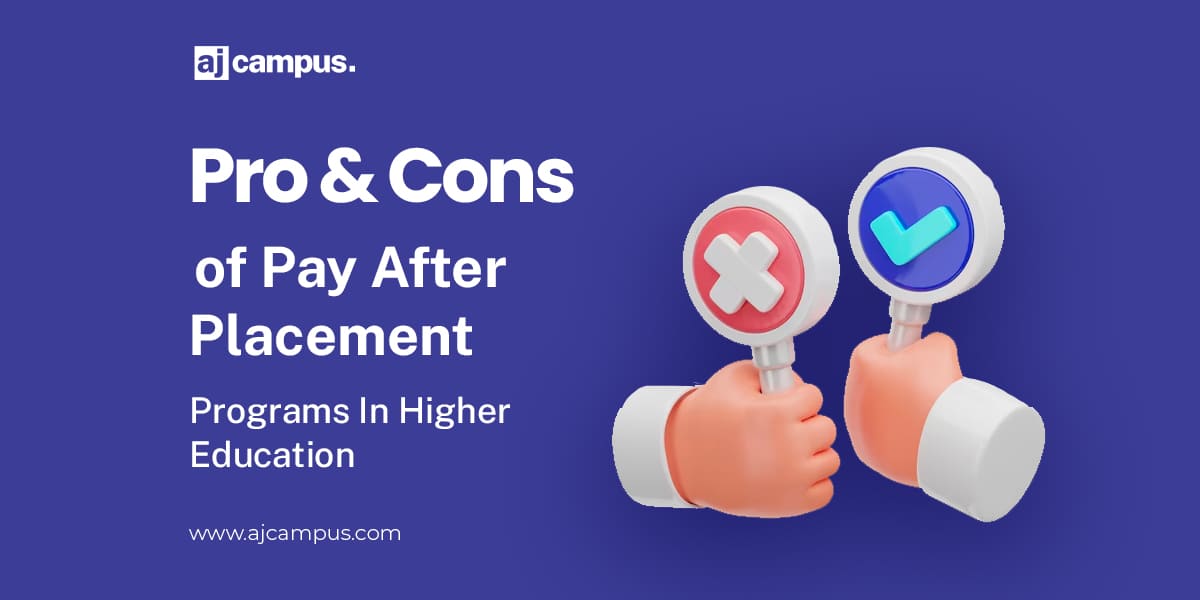Pro And Cons Of Pay After Placement
By Asha Rani, Last Updated 3 May, 2023 4 min read

The Pro And Cons Of Pay After Placement Programs In Higher Education
What is Pay after Placement?
According to the concept of “pay after placement,” you only pay for your education and training once you’ve been offered a job with an appropriate salary.
This idea is made possible through a financial contract between you and the institute known as Pay-after-placement program is quickly becoming popular, and they are committed to helping the nation’s education system become more focused on results, which is something we really needed.
The best way to get your ideal job is through pay after placement (PAP). The PAP course structure was created specifically to help you gain skills that are necessary for the workplace.
The goal of this effort is to remove all barriers to achievement that students might face.The student is exempted from paying the fee under the PAP program up until the student is placed.
Therefore, there is no cost to you during the training period to attend the course. After joining a company paying you three LPA or more, you will start paying as soon as you receive the first payment.
Why should you go for pay after placement program?
For some students, pay after placement program, sometimes referred to as income sharing agreements (ISAs), can be an excellent choice. The following are some factors for thinking about this kind of program:
- Education access: Pay after placement program might give students who do not have the financial resources to pay for their education ahead access to it.
- Financial stress is reduced since, unlike traditional student loans, payments on an ISA can be put off until the student is employed and producing a set amount of money. Students’ financial burdens may be reduced as a result, particularly in the early years of their careers when their income may be lower.
- Shared risk: When participating in pay after placement program, both the institution and the student share the financial risk of the education investment. The school also won’t be funded if the student doesn’t achieve. In other words, the institution has a duty to offer top-notch instruction that prepares its graduates for promising careers.
- Flexibility: Based on the student’s income after graduation, pay after placement program often offer more flexible payment choices. This means that payments can be modified if a student’s income is lower than predicted.
This program can also give students the passion they need to advance in their jobs. Students have a financial motivation to perform well and generate a high salary because their payments are dependent on it.In general, students who are looking for a more adaptive and affordable approach to fund their education may find pay after placement program to be a good choice.
The advantages of pay after placement programs are:
There is lot of advantages of this program. Some of the major advantages are discussed below:
Pros:
The benefits of PAP schemes are as follows:
- No need to pay until you land a job: One of the biggest benefits of PAP program is that you don’t have to pay anything until you secure a job. Once you secure employment and start receiving a regular income, you will only need to make a payment. However, some organizations offer a minimum package guarantee, so if you do not receive job offers in that range, you are not required to pay anything.
- Placement Assistance: One of the main motives for joining PAP program is the company’s promise to help participants secure jobs. They are connected to numerous employers and will be able to locate one. They have relationships with numerous employers and can locate a position that fits your skills and experience.
- Premium and Dynamic Courses: The institutes’ courses are focused on results and created by industry specialists. To help you become ready for the work, there are also experts, mentors, and coaches available.
- Easy vocation Pivot: The biggest benefit of the PAP plan is that anyone can switch rapidly to their preferred vocation. These courses are typically targeted at the IT industry, and with their guidance, transitioning to the IT industry is made simple.
Cons:
This program is not so popular among students, because it is newly launched and offered by limited institutions. This creates a little bit of trust issue with the students, as they are not able to trust this program fully. So there are no cons of this program.
Conclusion
PAP is a great way to speed up your career change and land positions at top technology companies without having to worry about money or up skilling. You can choose the best platform and get started on the path to success by doing some research.
FAQ’s
Que: What is pay after placement program?
Ans: PAP is a program is which the student is excluded from paying the fee under the PAP program up until the student is placed. Therefore, there is no cost to you during the training period to attend the course. After joining a company paying you three LPA or more, you will start paying as soon as you receive your first paycheck.
Que: How does PAP work?
Ans: Pay after placement proves successful because it enables students or job seekers to receive training without having to pay any initial fees. After being successfully hired, they give the training facility or placement agency a defined portion of their salary.
Que: What are the benefits of PAP?
Ans: -Fewer burdens on students or job searchers who need more money to pay education costs.
– Since their income has a direct relationship with the employment success of their students, training providers have a greater responsibility to ensure that their students are successfully placed in jobs.
– Gives students or job seekers a chance to test out training programs without worrying about losing money if they don’t land a job.
Que: Is pay after placement legal?
Ans: PAP Agreement is a legal contract that makes education at Masai outcome-based. It is not an education loan, as you do not have to pay any interest & you do not require any collateral.
Que: Is it good to join pay after the placement program?
Ans: It is a great program for one who those are financially weak and cannot afford to pay the higher fees of the colleges.




